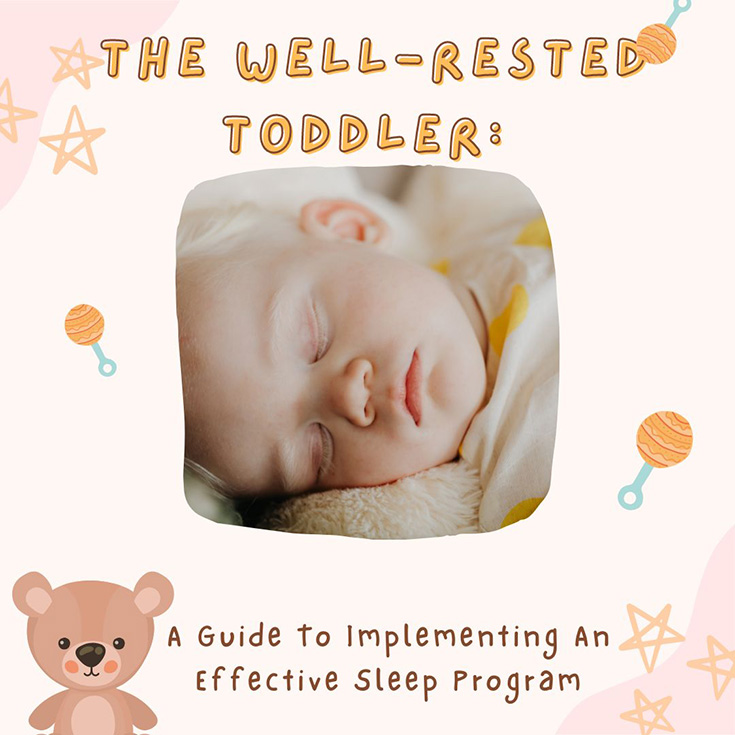Sleep plays a vital role in the healthy development and overall well-being of your little ones. It’s crucial to establish healthy sleep habits from an early age to ensure your baby gets the restorative rest they need.
Knowing the right toddler sleep program can make your journey easier. After all, a well-rested toddler is generally happier and less prone to meltdowns, so you can have a good night’s sleep as well as a parent.
Let’s explore the importance of sleep for toddlers and provide practical tips and strategies to implement an effective sleep program, setting the stage for a lifetime of restful nights.
Understanding Toddler Sleep Needs: How Much Sleep is Enough?
To develop an effective sleep program, it’s crucial to understand your toddler’s sleep needs and establish age-appropriate sleep schedules. Here’s a breakdown of the recommended sleep durations for toddlers:
- Toddlers aged 1 to 2 years typically need around 11 to 14 hours of sleep per day, including nighttime sleep and naps.
- As toddlers approach 3 years old, their sleep needs to decrease slightly to around 10 to 13 hours per day.
However, it’s important to note that every child is unique, and individual sleep needs may vary within the recommended ranges.
Creating a Sleep-Friendly Environment for Your Toddler
Providing a sleep-friendly environment sets the stage for restful nights and helps your toddler feel safe and comfortable in their sleep space. Consider the following factors when creating an ideal sleep environment:
- Ensure the room is cool, quiet, and dark, promoting optimal sleep conditions.
- Use blackout curtains or shades to block out excess light.
- Opt for a comfortable and age-appropriate mattress and bedding.
Establishing a Consistent Bedtime Routine for Your Toddler
A consistent bedtime routine helps signal to your toddler that it’s time to wind down and prepare for sleep. Establishing a soothing routine can promote relaxation and ease the transition into sleep. Consider the following elements for a successful bedtime routine:
- Start the routine at the same time each night, providing predictability for your toddler.
- Include calming activities such as bath time, reading a story, or gentle play.
- Dim the lights in the room to create a relaxing atmosphere.
Consistency and repetition in the bedtime routine can help your toddler, or newborn feel secure and prepared for sleep.
Transitioning from Crib to Toddler Bed: Tips and Strategies
As your toddler grows, you may need to transition them from a crib to a toddler bed. This milestone can impact their sleep habits. Here are some tips and strategies for a smooth transition:
- Introduce the toddler bed gradually, allowing your child to become familiar with it during the daytime.
- Create a positive association with the new bed by involving your toddler in the process of choosing to bed or decorating their sleep space.
- Reinforce bedtime routine and expectations, emphasizing that the new bed is for sleep.
Fun fact: Transitioning from a crib to a toddler bed signifies a milestone in your child’s independence and growth, so make sure to make all the memories you can!
Dealing with Common Sleep Challenges in Toddlers
Toddlers may experience various sleep challenges that can disrupt their restful nights. Understanding these challenges can help you address them effectively. Here are some common sleep challenges in toddlers and strategies to overcome them:
- Bedtime resistance: Establish clear and consistent boundaries, maintain a soothing bedtime routine, and use positive reinforcement.
- Night wakings: Ensure your toddler’s needs are met, such as hunger or comfort, and gradually reduce nighttime interactions.
- Bedtime fears: Offer reassurance, create a secure sleep environment, and use comforting techniques like nightlights or favorite toys.
Many toddlers experience an increase in imaginative play and vivid dreams, which can contribute to bedtime fears. When this surfaces, reassure your little one and give them your warmth.
Nurturing Independent Sleep Skills in Your Toddler
Teaching your toddler independent sleep skills is an essential part of establishing healthy sleep habits. Here are some techniques to foster your toddler’s ability to self-soothe and fall asleep independently:
- Encourage self-settling by placing your toddler in bed while drowsy but still awake.
- Use a transitional object like a favorite stuffed animal or blanket for comfort.
- Gradually increase the time you wait before responding to your toddler’s calls during the night.
- Fun fact: Independent sleep skills empower your toddler to feel confident and secure in their ability to fall asleep on their own.
Managing Nap Times for Toddlers
Nap times are crucial for your toddler’s overall sleep routine. Here are some guidelines for managing nap times:
- Offer age-appropriate and consistent nap schedules.
- Create a nap environment similar to their nighttime sleep space.
- Consider adjusting nap durations and timings as your toddler grows.
The transition from two naps to one typically occurs between 15 to 18 months of age, but individual readiness may vary.
Addressing Separation Anxiety and Bedtime Fears
Separation anxiety and bedtime fears are common in toddlers and can affect their sleep. Here’s how you can address these concerns:
- Offer reassurance and comfort during separation anxiety episodes.
- Use transitional objects or nightlights to alleviate bedtime fears.
- Create a safe and secure sleep environment to help your toddler feel protected.
Separation anxiety and bedtime fears are normal developmental phases that most toddlers experience, so you don’t need to worry about this being a rare phenomenon.
Frequently Asked Questions About Toddler Sleep
Here are some frequently asked questions about toddler sleep, along with their answers
Why is my toddler suddenly waking up at night?
- Nighttime awakenings can be due to developmental milestones, changes in routine, or temporary disruptions like illness.
How can I help my toddler sleep through the night?
- Establish a consistent bedtime routine, create a sleep-friendly environment, and encourage self-soothing skills.
Should I allow my toddler to sleep in my bed?
- Co-sleeping is a personal choice, but it’s essential to prioritize safety and establish clear boundaries.
Final Words
By implementing an effective sleep program and nurturing healthy sleep habits from the start, you are empowering your toddler with the tools they need for a lifetime of restful nights and healthy sleep patterns.
Understanding their sleep needs, creating a sleep-friendly environment, and addressing common sleep challenges will contribute to their overall well-being and happiness.
Remember, consistency, patience, and love are the keys to establishing healthy sleep habits that will benefit your toddler now and in the future. Embrace this journey and watch your little one flourish with well-deserved sweet dreams.







Speak Your Mind